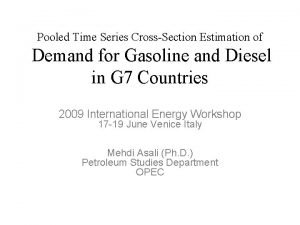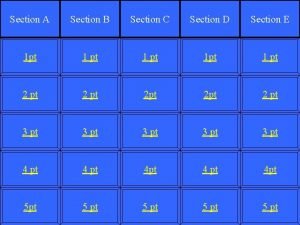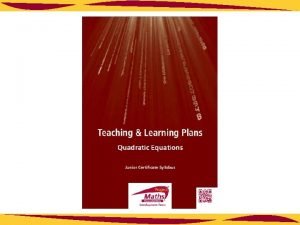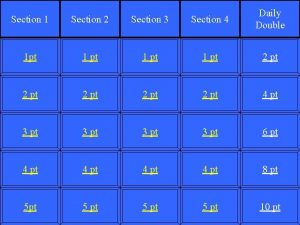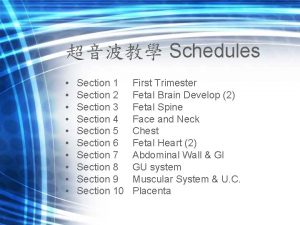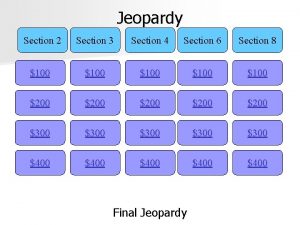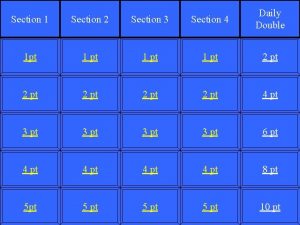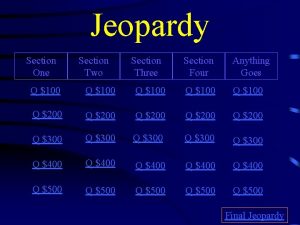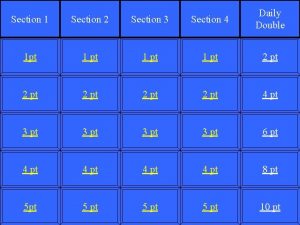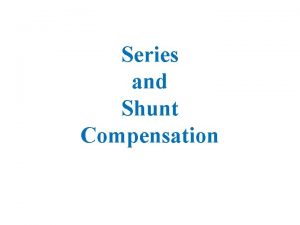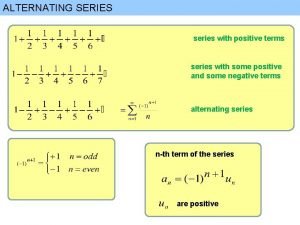SECTION 8 2 SERIES SERIES v If we


















- Slides: 18

SECTION 8. 2 SERIES

SERIES v. If we try to add the terms of an infinite sequence we get an expression of the form a 1 + a 2 + a 3 + ··· + an + ··· 8. 2 P 2

INFINITE SERIES v. This is called an infinite series (or just a series). n It is denoted, for short, by the symbol. v. However, does it make sense to talk about the sum of infinitely many terms? 8. 2 P 3

INFINITE SERIES v. It would be impossible to find a finite sum for the series 1 + 2 + 3 + 4 + 5 + ··· + n + ··· n n If we start adding the terms, we get the cumulative sums 1, 3, 6, 10, 15, 21, . . . After the nth term, we get n(n + 1)/2, which becomes very large as n increases. 8. 2 P 4

INFINITE SERIES v. However, if we start to add the terms of the series we get: 8. 2 P 5

INFINITE SERIES v. The table shows that, as we add more and more terms, these partial sums become closer and closer to 1. n In fact, by adding sufficiently many terms of the series, we can make the partial sums as close as we like to 1. 8. 2 P 6

INFINITE SERIES v. So, it seems reasonable to say that the sum of this infinite series is 1 and to write: v. We use a similar idea to determine whether or not a general series (Series 1) has a sum. 8. 2 P 7

INFINITE SERIES v. We consider the partial sums s 1 = a 1 s 2 = a 1 + a 2 s 3 = a 1 + a 2 + a 3 + a 4 n In general, 8. 2 P 8

INFINITE SERIES v. These partial sums form a new sequence {sn}, which may or may not have a limit. v. If exists (as a finite number), then, as in the preceding example, we call it the sum of the infinite series Σan. 8. 2 P 9

Definition 2 v. Given a series its nth partial sum: , let sn denote v. If the sequence {sn} is convergent and exists as a real number, then the series Σan is called convergent and we write: n n The number s is called the sum of the series. Otherwise, if the sequence {sn} us divergent, then the series is called divergent. 8. 2 P 10

SUM OF INFINITE SERIES v. Thus, the sum of a series is the limit of the sequence of partial sums. n So, when we write , we mean that, by adding sufficiently many terms of the series, we can get as close as we like to the number s. v. Notice that: 8. 2 P 11

SUM OF INFINITE SERIES VS. IMPROPER INTEGRALS v. Compare with the improper integral n n To find this integral, we integrate from 1 to t and then let t → ∞. For a series, we sum from 1 to n and then let n → ∞. 8. 2 P 12

Example 1 v. An important example of an infinite series is the geometric series v. Each term is obtained from the preceding one by multiplying it by the common ratio r. n We have already considered the special case where a = ½ and r = ½ earlier in the section. 8. 2 P 13

GEOMETRIC SERIES v. If r = 1, then sn = a +… + a = na → ±∞ n Since doesn’t exist, the geometric series diverges in this case. v. If r ≠ 1, we have sn = a + ar 2 + … + ar n– 1 and rsn = ar + ar 2 + … +ar n– 1 + ar n 8. 2 P 14

GEOMETRIC SERIES v. Subtracting these equations, we get: sn – rsn = a – ar n v. If – 1 < r < 1, we know from Result 8 in Section 8. 1 that r n → 0 as n → ∞. 8. 2 P 15

GEOMETRIC SERIES v. So, n Thus, when |r | < 1, the series is convergent and its sum is a/(1 – r). v. If r ≤ – 1 or r > 1, the sequence {r n} is divergent by Result 8 in Section 8. 1 v. So, by Equation 3, does not exist. n Hence, the series diverges in those cases. 8. 2 P 16

GEOMETRIC SERIES v. Figure 1 provides a geometric demonstration of the result in Example 1. v. If s is the sum of the series, then, by similar triangles, v. So, 8. 2 P 17

GEOMETRIC SERIES v. We summarize the results of Example 1 as follows. The geometric series is convergent if |r | < 1 and the sum of the series is: If |r | ≥ 1, the series is divergent. 8. 2 P 18
 Maclaurin series vs taylor series
Maclaurin series vs taylor series Balmer series lyman series
Balmer series lyman series Taylor series of composite function
Taylor series of composite function Taylor series lesson
Taylor series lesson Ibm p series models
Ibm p series models Shunt feedback amplifier analysis
Shunt feedback amplifier analysis Series aiding and series opposing
Series aiding and series opposing Arithmetic sum formula
Arithmetic sum formula Pooled time series
Pooled time series Section view
Section view Revolve section view
Revolve section view Partial section view
Partial section view Work and energy section 2 describing energy
Work and energy section 2 describing energy Concept mapping chapter 10 meiosis 1 and meiosis 2
Concept mapping chapter 10 meiosis 1 and meiosis 2 7 series fpga architecture
7 series fpga architecture Zoll elearning
Zoll elearning X factor bulgaria 2015
X factor bulgaria 2015 Favourite tv channel
Favourite tv channel Pta forum
Pta forum








